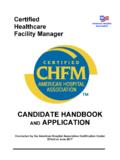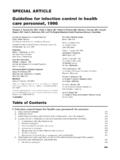Transcription of Emergency Preparedness for Hospice and Home Health ...
1 Emergency Preparedness for Hospice and home Health agencies : proposed Rule Mary St. Pierre, RN, BSN, MGA. Objectives State CMS rationale for Emergency Preparedness requirements List Emergency Preparedness proposed rules for hospices & home Health agencies Discuss home Health agency and Hospice implementation of the CMS Emergency Preparedness checklist History Impetus for Action Hurricane Katrina, H1N1, September 11. Presidential directive CMS Emergency Preparedness Stakeholder Communication Forum CMS & HHS. State agencies Provider associations Accreditation organizations Resident & patient advocate groups Safety and quality organizations Potential Hazardous Events Pandemics Hurricanes Tornados Fires Earthquakes Power outages Chemical Spills Terrorist attacks Etc.
2 ( floods, bridge collapses, nuclear accidents). CMS Determined Shortfalls of Current Regulations Communication to coordinate with other systems of care within local jurisdictions Contingency Planning Training of personnel CMS GOAL. Establish and maintain an Emergency Preparedness program Address medical and non-medical needs Ensure predictable staff behavior Enable government agencies and Health care providers to respond in manner that is: Timely Collaborative Organized Effective Presently: Hospice Emergency Preparedness As of March 2013 (c)(1)(ii) Physical environment Hospice inpatient facilities: Written disaster Preparedness plan Periodically rehearsed Procedures followed in internal or external disaster Procedures for the care of casualties (patients and staff).
3 proposed : Hospice Inpatient Facilities Policies and procedures to address the following: (i) A means to shelter in place for patients, employees (ii) Safe evacuation from the Hospice , including Transportation Identification of evacuation location(s). Primary and alternate means of communication with external sources of assistance (iii) The provision of subsistence needs for Hospice employees and patients (evacuees or shelter in place). (A) Food, water, and medical supplies. Hospice Inpatient (B) Alternate sources of energy to maintain (1) Temperatures to protect patient Health and safety and for the safe and sanitary storage of provisions. (2) Emergency lighting. (3) Fire detection, extinguishing, and alarm systems. (C) Sewage and waste disposal (iv) The role of the Hospice under a waiver in provision of care and treatment at alternate care site identified by Emergency management officials Hospice in the home Hospice home vs.
4 home Health proposed requirements Similar language Same elements Hospice and home Health Emergency Preparedness proposed Rule home Health agencies and Hospices must Develop Maintain Update annually an Emergency Preparedness Program and Plan Federal Emergency Preparedness proposed Rule Based on hospital requirements An all hazards approach Tailored to each providers' and suppliers' unique needs May decide Not to open their facilities or may close them, Have patients and staff remain at home or sent to shelter ** Rule does not specify quantity or level of detail of the program Federal home Health Emergency Preparedness proposed Rule Exceptions from hospital rule Safe evacuation Shelter in place Provision of care at alternate care sites Provision of occupancy information Hospice & home Health Emergency Preparedness proposed Rule Additions to hospital requirements.
5 Policies and procedures for Emergency Preparedness plan for each patient Informing State and local officials of patients needing evacuation Informing authority of jurisdiction of needs and ability to provide assistance Four Emergency Preparedness Program Elements Risk Assessment and Planning Policies and Procedures Communication Plan Training and Testing Risk Assessment Resources Must conduct and document an risk assessment All-hazard approach Undated annually National Planning Scenarios Risk Assessment Identification of all hazards that may affect organization Direct Indirect Facility-based Community-based Identification essential agency functions Analysis of vulnerabilities determined for each identified hazard ( impact on agency operation). Determination of specific actions to be taken Risk Assessment Specific actions to be taken for each hazard Identify key staff responsible for executing plan Identify staffing requirements and responsibilities Consider staff notification of emergencies and duties Categorize and triage patient based on needs, characteristics Identify supplies/equipment to sustain operations 3-10.
6 Days Risk Assessment Specific actions to be taken: Determine facility's hazard vulnerabilities Consider agency location, service area Identify communication issues, evacuation routes, fuel needs Consider financial and security needs Identify other providers/suppliers with which to collaborate Optional: consider meeting staff needs ( transportation, sheltering staff/family members). Emergency Preparedness Plan The HHA/ Hospice must: Develop and maintain an Emergency Preparedness plan Update plan at least annually Resource: An Emergency Planning Guide for America's Communities .pdf Emergency Preparedness Plan Strategies for addressing Emergency events Identification of types of services able to provide in Emergency Plans for acceptance of new patients Plans for caring for new patients Delegation of authority Succession plan Emergency Preparedness Plan Process to ensure cooperation and collaboration with local and national Emergency Preparedness official efforts Document efforts to contact officials and participation in planning Optional: participate in healthcare coalitions, share information, plans, resources, training Note: Ensure appropriateness of agency's role in Emergency situations Emergency Plan: Policies &.
7 Procedures Plans for the Hospice /HHA's patients during a natural or man-made disaster Individual plans for each patient as part of the comprehensive patient assessment Ongoing evaluation of medical & psychiatric condition and home environment Optional Method to inform patients & families of role of HHA in Emergency Emergency Plan: Policies &. Procedures Procedures to inform Emergency Preparedness officials about Hospice /HHA at-risk patients in need of evacuation Must be HIPAA compliant At-risk patients: individuals who require additional response assistance due to needs in maintaining independence, or communication, transportation, supervision, or medical care A system to track the location during and after Emergency ( JPATS). Staff Patients under care A system of medical documentation that Preserves patient information, confidentiality Ensures records are secure and readily available Emergency Plan: Policies &.
8 Procedures Development of Arrangements with other HHAs/Hospices or providers to receive patients Method to share Health information Back up electronic information Louisiana Use of volunteers in Emergencies and other staffing situations (Resources in NPR). Process and agency role for integration of State or Federally designated Health care professionals to address surge needs Communication Plan Communication plan that is compliant with Federal &. State laws Developed Maintained Reviewed annually Communication Plan Components Contingencies for communication infrastructure if telephone failures ( , walkie-talkies, ham radios, text messaging systems, etc.). Communication procedures to receive Emergency warning/alerts Procedures for communication with staff.
9 Patients/families before during and after emergencies Procedures for communicating with Emergency management agencies Communication Plan Components Copies of any state and local Emergency planning regulations or requirements Facility personnel names and contact information Contact information of local and state Emergency managers Facility organization chart Building construction and Life Safety systems information Specific information about the characteristics and needs of the individuals for whom care is provided Communication Plan Components The communication plan must include names and contact information for Staff Entities providing services under arrangement. Patients' physicians Other Hospices/HHAs Volunteers Communication Plan Components Contact information for Federal, State, tribal, regional, or Local Emergency Preparedness staff Other sources of assistance.
10 Communication Plan Components Method for sharing with other Health care providers Information Medical documentation A means of providing information about General condition and location of patients Hospice 's/HHA's needs Hospice 's/HHA's and its ability to provide assistance Training and Testing A Hospice /HHA Training and Testing Program must be Developed Maintained Reviewed and updated at least annually Training and Testing Requirements Training Provide initial training in Preparedness policies and procedures to (consistent with role). Existing staff, contractors, volunteers New staff, contractors, volunteers Provide Emergency Preparedness training at least annually Maintain documentation of training Ensure staff can demonstrate knowledge or Emergency procedures Training and Testing Requirements Testing Conduct drills and exercises to test Emergency plan Participate in a community mock disaster drill at least annually unless If none, conduct facility-based mock disaster drill at least annually, or If an actual Emergency requires activation of plan the Hospice /HHA is exempt mock disaster drill for 1 year Training and Testing Requirements Testing Conduct a paper-based, tabletop exercise annually group discussion using clinically relevant Emergency scenario.


